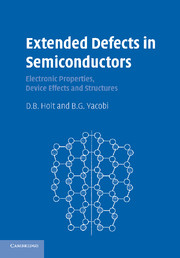Book contents
- Frontmatter
- Contents
- Preface
- 1 Semiconducting materials
- 2 An introduction to extended defects
- 3 Characterization of extended defects in semiconductors
- 4 Core structures and mechanical effects of extended defects specific to semiconductors
- 5 The electrical, optical and device effects of dislocations and grain boundaries
- 6 Point defect materials problems
- Index
- References
6 - Point defect materials problems
Published online by Cambridge University Press: 10 September 2009
- Frontmatter
- Contents
- Preface
- 1 Semiconducting materials
- 2 An introduction to extended defects
- 3 Characterization of extended defects in semiconductors
- 4 Core structures and mechanical effects of extended defects specific to semiconductors
- 5 The electrical, optical and device effects of dislocations and grain boundaries
- 6 Point defect materials problems
- Index
- References
Summary
Introduction
One final category of extended defect remains, although it is not generally so described. This consists of undesired, non-uniform distributions of native point defects, impurities and alloy composition variations. These point defect maldistributions render the initial material properties non-uniform and interfere with the controlled introduction of the variations required for devices.
Semiconductor processing starts with material that is uniformly sufficiently pure and perfect to exhibit the intrinsic properties of the semiconductor. Controlled concentrations of selected impurities are then introduced into chosen volumes to achieve the desired extrinsic properties. These include, for example, p- or n-type conductivity of the necessary value or luminescent emission of a certain wavelength and efficiency. For this, the impurity must occur as a uniform, random distribution of single, isolated impurity atoms of the desired element on substitutional sites in the required concentration. This chapter is concerned with crystal growth phenomena affecting point defect distributions and so materials uniformity and, therefore, capable of leading to failure to achieve successful device fabrication.
Because of their importance and relative simplicity, point defects have been studied intensively throughout the history of semiconductor physics and chemistry. The properties of point defects are therefore well treated in many review articles (Queisser and Haller 1998) and books such as Stoneham (2000) as well as series of conferences. We shall, therefore, give only the necessary minimum background on a number of points required for the present purpose.
Information
- Type
- Chapter
- Information
- Extended Defects in SemiconductorsElectronic Properties, Device Effects and Structures, pp. 606 - 624Publisher: Cambridge University PressPrint publication year: 2007
